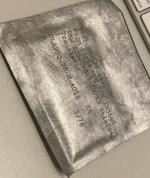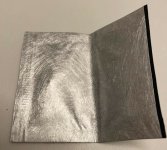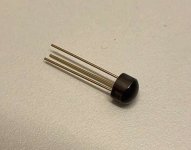vrs42
Veteran Member
It has happened to me a couple of times now. I go to Mouser, and I spend an afternoon staring at data sheets for switching diodes. I'm looking for diodes with low and high forward voltage drops, to replace standard bits of the logic in Bxxx, Rxxx, and Sxxx logic gates.
There are almost always two types used:
D664 is used to AND inputs without shorting them, and ideally would drop as little voltage as possible. (If they'd been readily available, they'd probably use a Schottky diode.)
D662 is used to form an inexpensive voltage regulator. Four such diodes are used in series, and their cumulative drop is expected to be 3V. The other 12V (out of 15) is dropped across a 1500 ohm resistor, which also limits the current to about 8 mA. For this to work, the forward drop needs to be about 0.75V per diode at that current. The diodes will quickly shunt less current if the load shifts.
Anyway, my diodes arrived today, and I built a regulator as described above and...the voltage drop is 2.88V regardless of which of my carefully selected diodes is used. Admittedly, an error margin of 4% or so isn't terrible, but it isn't great either, and I was also hoping for a lower value on my D664 replacements. (The diodes I ordered this time are 1N914 and 1N916 with specific revision numbers mentioned on the data sheets, but seem to behave identically regardless.)
Has anyone had any luck or care to chime in on what best to replace these diodes with? Ultimately I'm trying to fabricate some missing modules for my Logic Lab. The issue would also be relevant for straight-8 or 8/S repair, as well as various peripheral gear from the Negibus era.
Thanks,
Vince
There are almost always two types used:
D664 is used to AND inputs without shorting them, and ideally would drop as little voltage as possible. (If they'd been readily available, they'd probably use a Schottky diode.)
D662 is used to form an inexpensive voltage regulator. Four such diodes are used in series, and their cumulative drop is expected to be 3V. The other 12V (out of 15) is dropped across a 1500 ohm resistor, which also limits the current to about 8 mA. For this to work, the forward drop needs to be about 0.75V per diode at that current. The diodes will quickly shunt less current if the load shifts.
Anyway, my diodes arrived today, and I built a regulator as described above and...the voltage drop is 2.88V regardless of which of my carefully selected diodes is used. Admittedly, an error margin of 4% or so isn't terrible, but it isn't great either, and I was also hoping for a lower value on my D664 replacements. (The diodes I ordered this time are 1N914 and 1N916 with specific revision numbers mentioned on the data sheets, but seem to behave identically regardless.)
Has anyone had any luck or care to chime in on what best to replace these diodes with? Ultimately I'm trying to fabricate some missing modules for my Logic Lab. The issue would also be relevant for straight-8 or 8/S repair, as well as various peripheral gear from the Negibus era.
Thanks,
Vince



